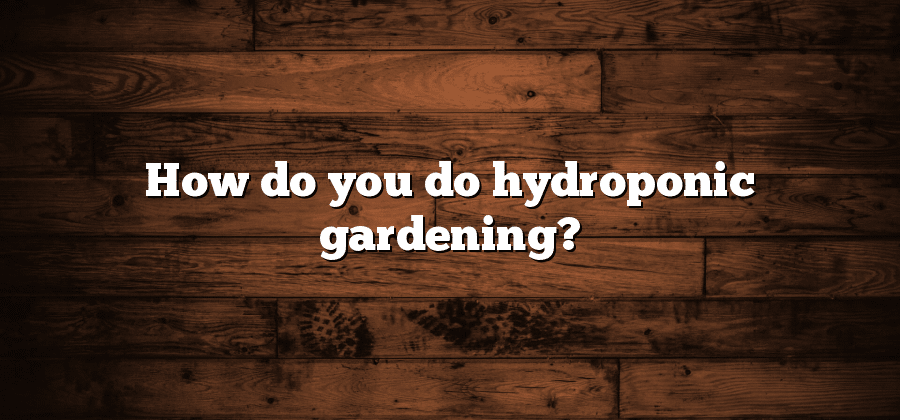Benefits of Hydroponic Gardening
Hydroponic gardening, a method of growing plants without soil, offers a multitude of benefits that make it an attractive choice for both professional and amateur horticulturists. One of the primary advantages is the ability to grow crops in any season and in any location, regardless of climate or soil conditions. By controlling key environmental factors such as temperature, humidity, and light intensity, hydroponic systems create ideal growing conditions that maximize plant growth and yield.
Another significant benefit is the efficient use of resources, particularly water. Traditional soil-based gardening often leads to water wastage through runoff and evaporation. In hydroponics, water is recirculated in a closed system, reducing water consumption by up to 90% compared to traditional farming methods. This not only conserves a precious resource but also minimizes the environmental impact by cutting down on the need for pesticides and fertilizers that can contaminate soil and water sources. Additionally, the controlled environment of hydroponics mitigates weed growth, reducing the need for herbicides and manual labor.
Essential Equipment for Hydroponic Gardening
When it comes to hydroponic gardening, having the right equipment is essential for success. No matter your level of experience, investing in quality tools and supplies will ensure that your plants thrive in a controlled indoor environment. One of the most important pieces of equipment you will need is a grow tent or grow room. This enclosed space provides the ideal conditions for plants to grow by controlling factors such as temperature, humidity, and lighting. Additionally, a grow tent allows for easy installation of a ventilation system, which is crucial for maintaining air circulation and preventing the buildup of heat and moisture.
Another essential equipment for hydroponic gardening is a high-quality lighting system. Since plants grown hydroponically do not have direct access to natural sunlight, it is important to provide them with artificial lighting. LED lights are the most commonly used option, as they are energy-efficient and produce little heat, reducing the risk of plant damage. When choosing a lighting system, consider the specific light spectrum required for different stages of plant growth, as well as the size of your grow space. Properly installed lighting will promote healthy growth and maximize yields in your hydroponic garden.
Selecting the Right Growing Medium
Hydroponic gardening is a soilless gardening technique that relies on a growing medium to support the plants and provide them with essential nutrients. Selecting the right growing medium is crucial for a successful hydroponic system as it directly affects the root development, nutrient absorption, and overall growth of the plants.
When choosing a growing medium for your hydroponic garden, it is important to consider factors such as water retention, aeration, pH stability, and nutrient availability. One commonly used growing medium is perlite, which is a lightweight material that provides excellent drainage and aeration for the roots. Another popular option is rockwool, a mineral fiber material that has great water retention capabilities and provides good support to the plants. Coconut coir, a byproduct of coconut husks, is another popular growing medium choice as it retains moisture well and has good nutrient retention properties. Ultimately, the selection of the right growing medium will depend on the specific needs of your plants and the environmental conditions of your hydroponic system.
Understanding Nutrient Solutions for Hydroponics
Hydroponic gardening, a soilless method of growing plants, requires careful attention to nutrient solutions. These solutions are essential for the plants’ growth and development, as they provide all the necessary minerals and elements that plants would typically obtain from the soil. By understanding the importance and composition of nutrient solutions, hydroponic gardeners can create optimal conditions for their plants to thrive.
The primary function of nutrient solutions is to deliver essential minerals and nutrients directly to the plant’s root system. These solutions are carefully formulated to ensure that plants receive all the necessary elements in the right proportions. By providing a well-balanced nutrient solution, hydroponic gardeners can effectively replace the benefits of traditional soil, allowing plants to grow faster and produce higher yields. Additionally, nutrient solutions in hydroponic gardening can be tailored to suit the specific needs of different plant varieties, enabling gardeners to optimize growth and achieve better results.
Choosing the Best Plants for Hydroponic Gardening
When it comes to hydroponic gardening, selecting the right plants is crucial for success. While many plants can thrive in a hydroponic system, certain factors need to be considered before making your choices. One important factor is the size of the plants. Since hydroponic systems often have limited space, it is essential to choose plants that are compact and do not grow too tall or wide. This will ensure that the plants can be properly supported and that the system can accommodate them without becoming overcrowded. Additionally, it is important to select plants that have a high yield potential so that you can maximize your harvest in the limited space provided by the hydroponic system.
Another factor to consider when choosing plants for hydroponic gardening is their nutrient requirements. Unlike traditional soil-based gardening, hydroponic systems rely on nutrient solutions to provide essential elements for plant growth. Therefore, it is important to select plants that can thrive in this type of environment and have specific nutrient requirements that can be easily met. Some plants, such as lettuce and herbs, have relatively low nutrient requirements and can grow well in a wide range of nutrient solutions. On the other hand, plants with higher nutrient demands, such as tomatoes or peppers, may require more specialized nutrient solutions to achieve optimal growth and yield. By taking into account the nutrient requirements of different plants, you can ensure that your hydroponic system can adequately meet their needs and support their growth.






